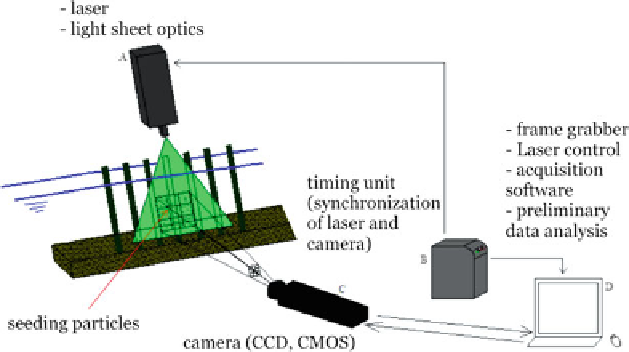Geoscience Reference
In-Depth Information
2.2 Principles of PIV Instrumentation
Particle Image Velocimetry is an indirect technique for measuring instantaneous
flow velocities in planar regions of the flow. It is thus neither a point-wise measure-
ment technique nor a profiler although it can be used as so. Its main novelty,
relatively to older techniques, is thus the possibility of calculating velocity gradi-
ents and thus out-of-plane vorticity.
PIV actually measures small displacements of tracer particles, illuminated by a
laser sheet, recorded by a video camera. It can measure the two in-plane velocity
components (2DPIV) or the three components (3DPIV), for which a second camera
is required. Figure
7
shows a typical 2DPIV layout, featuring a laser, generally
pulsed, with its optics, a video camera, both synchronized and controlled by
software, a frame grabber and processing software.
Although more recent than LDA, there is a considerable body of literature that
describes PIV hardware, methods and algorithms, more comprehensive than that
available to Doppler techniques. This is probably due to the fact that the quality of
PIV measurements depends mostly on data processing and less on hardware issues.
Comprehensive reviews can be found in Raffel et al. (
1998
) and Tropea et al.
(
2007
). Only a brief overview is offered in this section.
In the recent commercial systems, the laser source is generally a solid-state laser,
for instance, a Nd:YAG (Neodymium-doped Yttrium Aluminum garnet). It is thus
subjected to optical pumping, frequently with diode laser or white light. The Nd:
YAG laser depends on the temperature. At standard operating temperatures, it emits
at wavelength 1064 nm, in the infrared spectrum.
A pulsed laser is obtained by a quality switch (Q-switch) inside the cavity,
operated in a software-controlled triggered mode. Q-switches are generally
Fig. 7 Typical PIV layout

